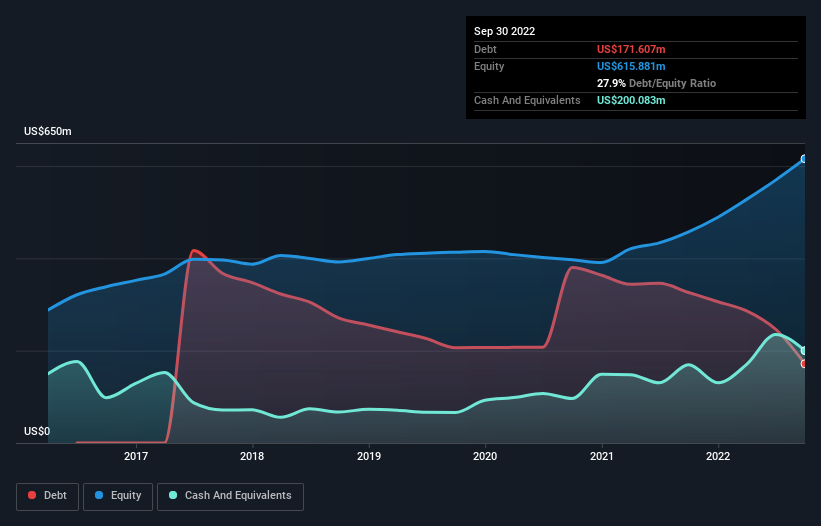
The external fund manager backed by Berkshire Hathaway’s Charlie Munger, Li Lu, makes no bones about it when he says ‘The biggest investment risk is not the volatility of prices, but whether you will suffer a permanent loss of capital.’ So it might be obvious that you need to consider debt, when you think about how risky any given stock is, because too much debt can sink a company. We can see that MaxLinear, Inc. (NASDAQ:MXL) does use debt in its business. But is this debt a concern to shareholders?
Why Does Debt Bring Risk?
Generally speaking, debt only becomes a real problem when a company can’t easily pay it off, either by raising capital or with its own cash flow. If things get really bad, the lenders can take control of the business. However, a more usual (but still expensive) situation is where a company must dilute shareholders at a cheap share price simply to get debt under control. By replacing dilution, though, debt can be an extremely good tool for businesses that need capital to invest in growth at high rates of return. The first thing to do when considering how much debt a business uses is to look at its cash and debt together.
View our latest analysis for MaxLinear
What Is MaxLinear’s Debt?
The image below, which you can click on for greater detail, shows that MaxLinear had debt of US$171.6m at the end of September 2022, a reduction from US$326.0m over a year. But it also has US$200.1m in cash to offset that, meaning it has US$28.5m net cash.

A Look At MaxLinear’s Liabilities
The latest balance sheet data shows that MaxLinear had liabilities of US$351.3m due within a year, and liabilities of US$215.5m falling due after that. Offsetting these obligations, it had cash of US$200.1m as well as receivables valued at US$178.1m due within 12 months. So its liabilities outweigh the sum of its cash and (near-term) receivables by US$188.7m.
Given MaxLinear has a market capitalization of US$2.85b, it’s hard to believe these liabilities pose much threat. Having said that, it’s clear that we should continue to monitor its balance sheet, lest it change for the worse. Despite its noteworthy liabilities, MaxLinear boasts net cash, so it’s fair to say it does not have a heavy debt load!
Even more impressive was the fact that MaxLinear grew its EBIT by 414% over twelve months. That boost will make it even easier to pay down debt going forward. The balance sheet is clearly the area to focus on when you are analysing debt. But it is future earnings, more than anything, that will determine MaxLinear’s ability to maintain a healthy balance sheet going forward. So if you’re focused on the future you can check out this free report showing analyst profit forecasts.
Finally, a company can only pay off debt with cold hard cash, not accounting profits. MaxLinear may have net cash on the balance sheet, but it is still interesting to look at how well the business converts its earnings before interest and tax (EBIT) to free cash flow, because that will influence both its need for, and its capacity to manage debt. Over the last two years, MaxLinear actually produced more free cash flow than EBIT. That sort of strong cash generation warms our hearts like a puppy in a bumblebee suit.
Summing Up
While it is always sensible to look at a company’s total liabilities, it is very reassuring that MaxLinear has US$28.5m in net cash. The cherry on top was that in converted 235% of that EBIT to free cash flow, bringing in US$287m. So we don’t think MaxLinear’s use of debt is risky. When analysing debt levels, the balance sheet is the obvious place to start. However, not all investment risk resides within the balance sheet – far from it. Be aware that MaxLinear is showing 2 warning signs in our investment analysis , you should know about…
If you’re interested in investing in businesses that can grow profits without the burden of debt, then check out this free list of growing businesses that have net cash on the balance sheet.
Valuation is complex, but we’re helping make it simple.
Find out whether MaxLinear is potentially over or undervalued by checking out our comprehensive analysis, which includes fair value estimates, risks and warnings, dividends, insider transactions and financial health.
Have feedback on this article? Concerned about the content? Get in touch with us directly. Alternatively, email editorial-team (at) simplywallst.com.
This article by Simply Wall St is general in nature. We provide commentary based on historical data and analyst forecasts only using an unbiased methodology and our articles are not intended to be financial advice. It does not constitute a recommendation to buy or sell any stock, and does not take account of your objectives, or your financial situation. We aim to bring you long-term focused analysis driven by fundamental data. Note that our analysis may not factor in the latest price-sensitive company announcements or qualitative material. Simply Wall St has no position in any stocks mentioned.
Source link
